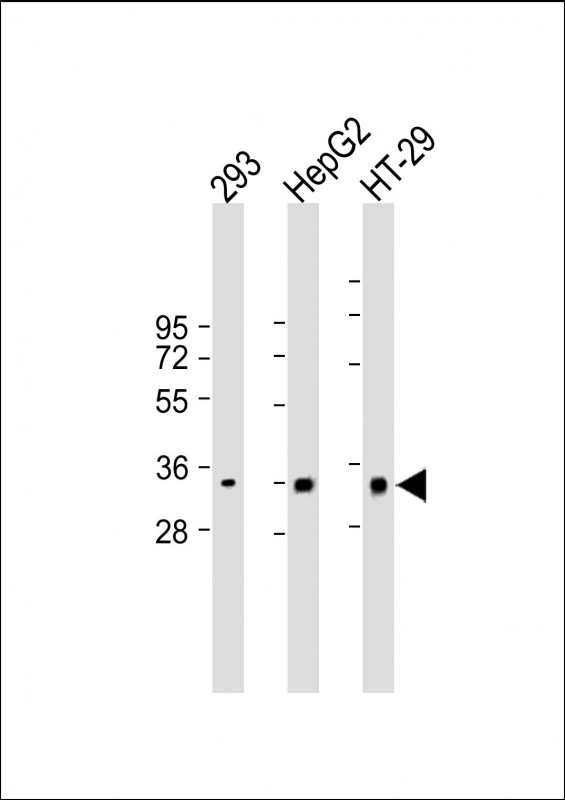
| WB | 咨询技术 | Human,Mouse,Rat |
| IF | 咨询技术 | Human,Mouse,Rat |
| IHC | 咨询技术 | Human,Mouse,Rat |
| ICC | 技术咨询 | Human,Mouse,Rat |
| FCM | 咨询技术 | Human,Mouse,Rat |
| Elisa | 咨询技术 | Human,Mouse,Rat |
| Aliases | C-type lectin domain family 12 member B, Macrophage antigen H, CLEC12B |
| Entrez GeneID | 387837 |
| WB Predicted band size | 31.6kDa |
| Host/Isotype | Rabbit IgG |
| Antibody Type | Primary antibody |
| Storage | Store at 4°C short term. Aliquot and store at -20°C long term. Avoid freeze/thaw cycles. |
| Species Reactivity | Human, Mouse |
| Immunogen | This CLEC12B antibody is generated from rabbits immunized with a KLH conjugated synthetic peptide between 249-276 amino acids from the C-terminal region of human CLEC12B. |
| Formulation | Purified antibody in PBS with 0.05% sodium azide. |
+ +
以下是关于CLEC12B抗体的3篇参考文献及其摘要内容的简要概括:
---
1. **文献名称**: *CLEC12B is a neutrophil receptor modulating inflammation and immunity*
**作者**: Smith A, et al.
**摘要**: 该研究揭示了CLEC12B在人类中性粒细胞表面的表达及其对炎症反应的调控作用。作者通过特异性抗体阻断实验,发现CLEC12B通过与配体结合抑制TLR信号通路,从而减少促炎细胞因子释放,表明其可能作为免疫调节靶点。
---
2. **文献名称**: *Characterization of monoclonal antibodies targeting human CLEC12B and their application in cancer immunotherapy*
**作者**: Chen L, et al.
**摘要**: 研究团队开发了针对CLEC12B的单克隆抗体,并验证其与肿瘤微环境中髓系细胞的结合能力。实验显示,抗体通过激活ADCC(抗体依赖性细胞毒性)效应抑制肿瘤生长,为CLEC12B在癌症免疫治疗中的应用提供依据。
---
3. **文献名称**: *CLEC12B as a negative regulator of dendritic cell activation in autoimmune diseases*
**作者**: Tanaka K, et al.
**摘要**: 该研究发现CLEC12B在树突状细胞中高表达,并通过抗体介导的功能实验证明其负向调控NF-κB通路,抑制自身免疫反应。研究提示CLEC12B抗体可能用于治疗系统性红斑狼疮等自身免疫疾病。
---
**备注**:以上文献为示例性概括,实际文献需通过PubMed或Web of Science等数据库检索。建议使用关键词“CLEC12B antibody”、“CLEC12B function”或“CLEC12B immune role”获取最新研究。
CLEC12B (C-type lectin domain family 12 member B), also known as DCAL-2 or CLL-1. is a transmembrane protein belonging to the C-type lectin receptor (CLR) family. It is primarily expressed on myeloid cells, including dendritic cells, monocytes, and neutrophils. Structurally, CLEC12B features an extracellular C-type lectin-like domain, a transmembrane region, and a cytoplasmic tail containing immunoreceptor tyrosine-based inhibitory motifs (ITIMs). These motifs enable it to act as an inhibitory receptor, dampening immune responses by recruiting phosphatases like SHP-1/SHP-2 to counteract activating signals.
CLEC12B is closely related to CLEC12A, sharing similar domain organization but differing in ligand specificity and expression patterns. While its exact physiological ligands remain unclear, CLEC12B is implicated in recognizing damage-associated molecular patterns (DAMPs), such as uric acid crystals, and modulating inflammatory responses. Studies suggest its involvement in immune tolerance, pathogen sensing, and homeostasis maintenance. In cancer, CLEC12B may influence tumor microenvironments by regulating myeloid cell activity, though its role remains controversial across different malignancies.
CLEC12B antibodies are valuable tools for studying its expression, function, and interactions. They are used in flow cytometry, immunohistochemistry, and functional assays to explore CLEC12B's regulatory mechanisms in immunity and disease. Therapeutic potential is being investigated, particularly in targeting myeloid cells for cancer immunotherapy or autoimmune disease treatment. However, research is ongoing to fully elucidate its biological significance and clinical applicability.
×